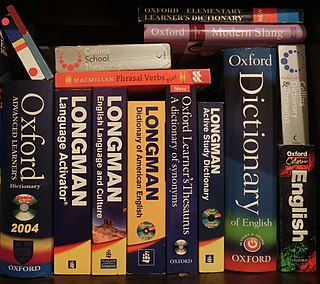The English language was first introduced to the Americas by British colonization, beginning in the late 16th and early 17th centuries. The language also spread to numerous other parts of the world as a result of British trade and colonisation and the spread of the former British Empire, which, by 1921, included about 470–570 million people, about a quarter of the world's population.

A definition is a statement of the meaning of a term. Definitions can be classified into two large categories, intensional definitions and extensional definitions. Another important category of definitions is the class of ostensive definitions, which convey the meaning of a term by pointing out examples. A term may have many different senses and multiple meanings, and thus require multiple definitions.
In linguistics, grammatical gender is a specific form of noun class system in which the division of noun classes forms an agreement system with another aspect of the language, such as adjectives, articles, pronouns, or verbs. This system is used in approximately one quarter of the world's languages. In these languages, most or all nouns inherently carry one value of the grammatical category called gender; the values present in a given language are called the genders of that language. According to one definition: "Genders are classes of nouns reflected in the behaviour of associated words."
Slang is language of an informal register that members of particular in-groups favor in order to establish group identity, exclude outsiders, or both.

A noun is a word that functions as the name of some specific thing or set of things, such as living creatures, objects, places, actions, qualities, states of existence, or ideas. Linguistically, a noun is a member of a large, open part of speech whose members can occur as the main word in the subject of a clause, the object of a verb, or the object of a preposition.
A dysphemism is an expression with connotations that are offensive either about the subject matter or to the audience, or both. Dysphemisms contrast with neutral or euphemistic expressions. Dysphemism is sometimes motivated by feelings such as fear, distaste, hatred, and contempt. Worded simply, a dysphemism is a derogatory or unpleasant term used instead of a pleasant or neutral one, such as "loony bin" for "mental hospital".

An idiom is a phrase or an expression that has a figurative, or sometimes literal, meaning. Categorized as formulaic language, an idiom's figurative meaning is different from the literal meaning. There are thousands of idioms, occurring frequently in all languages. It is estimated that there are at least twenty-five thousand idiomatic expressions in the English language.
Metonymy is a figure of speech in which a thing or concept is referred to by the name of something closely associated with that thing or concept.
Pleonasm is the use of more words or parts of words than are necessary or sufficient for clear expression: for example black darkness or burning fire. Such redundancy is, by traditional rhetorical criteria, a manifestation of tautology, and might be considered a fault of style. However, pleonasm may also be used for emphasis, or because the phrase has already become established in a certain form.
Sona is an international auxiliary language created by Kenneth Searight and described in a book he published in 1935. The word Sona in the language itself means "auxiliary neutral thing", but the name was also chosen to echo "sonority" or "sound".
In linguistics or any variety of language usage, hypercorrection is non-standard language use that results from the over-application of a perceived rule of language-usage prescription. A speaker or writer who produces a hypercorrection generally believes through a misunderstanding of these rules that the form is more correct or otherwise preferable, often combined with a desire to appear formal or educated.
In semiotics, linguistics, anthropology and philosophy of language, indexicality is the phenomenon of a sign pointing to some object in the context in which it occurs. A sign that signifies indexically is called an index or, in philosophy, an indexical.
In linguistics, a word is the smallest element that can be uttered in isolation with objective or practical meaning.
In semiotics, connotation arises when the denotative relationship between a signifier and its signified is inadequate to serve the needs of the community. A second level of meanings is termed connotative. These meanings are not objective representations of the thing, but new usages produced by the language group.
A direct reference theory is a theory of language that claims that the meaning of a word or expression lies in what it points out in the world. The object denoted by a word is called its referent. Criticisms of this position are often associated with Ludwig Wittgenstein.
In the philosophy of language, the nature of meaning, its definition, elements, and types, was discussed by philosophers Aristotle, Augustine, and Aquinas. According to them "meaning is a relationship between two sorts of things: signs and the kinds of things they mean ". One term in the relationship of meaning necessarily causes something else to come to the mind. In other words: "a sign is defined as an entity that indicates another entity to some agent for some purpose". As Augustine states, a sign is "something that shows itself to the senses and something other than itself to the mind".
In linguistics, volition is a concept that distinguishes whether the subject, or agent of a particular sentence intended an action or not. Simply, it is the intentional or unintentional nature of an action. Volition concerns the idea of control and for the purposes outside of psychology and cognitive science, is considered the same as intention in linguistics. Volition can then be expressed in a given language using a variety of possible methods. These sentence forms usually indicate that a given action has been done intentionally, or willingly. There are various ways of marking volition cross-linguistically. When using verbs of volition in English, like want or prefer, these verbs are not expressly marked. Other languages handle this with affixes, while others have complex structural consequences of volitional or non-volitional encoding.

Southern Sierra Miwok is an Utian language spoken by the Native American people called the Southern Sierra Miwok of Northern California. Southern Sierra Miwok is a member of the Miwok language family along with Lake Miwok, Coast Miwok (extinct), Saclan (extinct), Plains Miwok (extinct), Northern Sierra Miwok and Central Sierra Miwok. The Miwok languages are a part of the larger Penutian language stock. The original territory of the Southern Sierra Miwok people is similar to modern day Mariposa County, California. The Southern Sierra Miwok language is nearly extinct with only a few speakers existing today. However, as of 2012, an active revitalization program is underway.

Newspeak is the language of Oceania, a fictional totalitarian state and the setting of the novel Nineteen Eighty-Four (1949), by George Orwell. The ruling Party of Oceania created the Newspeak language to meet the ideological requirements of English Socialism (Ingsoc). Newspeak is a controlled language, of restricted grammar and limited vocabulary, meant to limit the freedom of thought—personal identity, self-expression, free will—that ideologically threatens the régime of Big Brother and the Party, who thus criminalized such concepts as thoughtcrime, contradictions of Ingsoc orthodoxy.

Ute is a dialect of the Colorado River Numic language, spoken by the Ute people. Speakers primarily live on three reservations: Uintah-Ouray in northeastern Utah, Southern Ute in southwestern Colorado, and Ute Mountain in southwestern Colorado and southeastern Utah. Ute is part of the Numic branch of the Uto-Aztecan language family.
Other dialects in this dialect chain are Chemehuevi and Southern Paiute. As of 2010, there were 1,640 speakers combined of all three dialects Colorado River Numic. Ute's parent language, Colorado River Numic, is classified as a threatened language, although there are tribally-sponsored language revitalization programs for the dialect.




